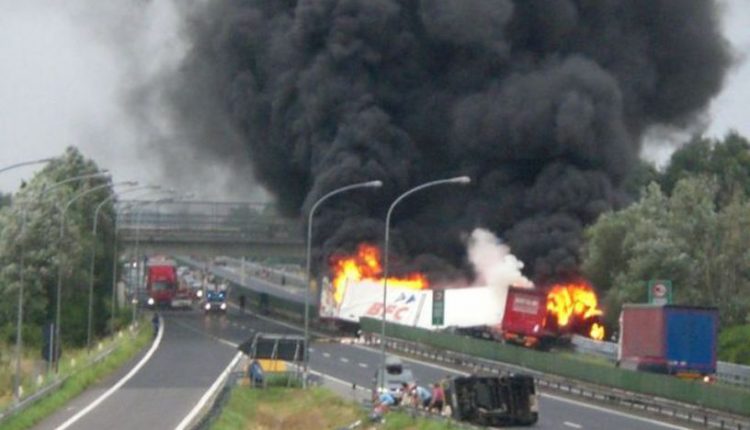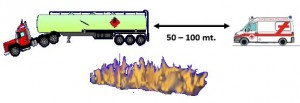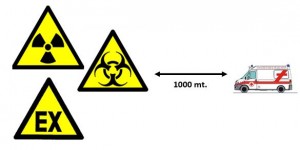
Road accidents: How paramedics recognize a risky scenario?
Whenever an ambulance crew reaches road accidents scenarios they must be careful, because dangerous goods can be present and it may not be safe! How to behave?
A paramedic and a nurse are on the ambulance in order to carry out the usual check-list. Suddenly on the vehicle display appears the signal “CODE RED”. Every emergency medical operator, whoever faced such situation can do only one thing: try to get more information as possible. We will see what road accidents with dangerous goods could provoke and how first responders have to approach to them.
Road accidents with dangerous goods: the experience
The nurse calls the Dispatch Centre with the service telephone and the paramedic starts driving the vehicle; with the emergency flashlights and sirens activated. The goal is trying to reach the target without jeopardizing yourself and others’ safety, but with the utmost speed.
The dispatch centre communicates that on the highway, a motor vehicle accident involving several vehicles has been reported by the motorists of the opposite lane, including a tanker lying upside down on one side.
Leaving aside the basic information on driving in an emergency, which is the common heritage of every good ambulance driver, it is appropriate to examine the procedural process at about 1 km from the “crash” scene.
When approaching this limit, the driver must, therefore:
- IF ON A MOTORWAY – Using the normal driving lanes whenever possible and reduce the speed to create a column behind the vehicle and thus avoid the arrival of other vehicles at high speed; for reversals or counter-traffic sections always wait for the presence and authorization of the Law Enforcement;
- IF ON URBAN OR RURAL ROADS – Always pay the utmost attention to pedestrians, vehicles and keep a moderate speed or, in any case, a suitable speed to be prepared to face the state of the road, also according to environmental and climatic conditions;
- If we have been communicated a potentially risky scenario (for example, ADR or RID transport), ALWAYS assess wind direction before the approach. You have to position windward to the site of the accident or release.
Road accidents with dangerous goods involved: cases of accidents and risk indicators
But what does it mean assessing the wind direction? The answer lies in identifying what is the dangerous object/situation to which we should stand upwind, which in our case is clearly the place of the crash. The methods to assess the wind direction are many: a plume of smoke, the tops of the trees, a flag or the more technological applications can detect the wind direction in real-time, taking into account the 3G or LTE coverage. (I highly recommend WIND ALERT, a free app available in both the iOS version on Apple store and for Android on Google play).
Once reached the place of the event, it is also advisable to assess the presence of risk indicators:
- more people on the ground without conscience
- unusual smells
- fumes or vapours, perhaps grazing the ground
- birds or other dead or dying animals
- vegetation discoloured
- liquid on the asphalt
- fire
The presence of these factors must necessarily suggest to the paramedics or first responders who drive the ambulance that the scenario is strongly at risk. So, it is appropriate to implement every possible way of self-protection. Below, some cases and relative safety distances are proposed, evaluated empirically, which however guarantee a more than optimal level of safety:
LOSS OF SUBSTANCES WITHOUT FIRE
![]() LOSS OF SUBSTANCES WITH FIRE THAT DOES NOT INVOLVE A TANK
LOSS OF SUBSTANCES WITH FIRE THAT DOES NOT INVOLVE A TANK
LOSS OF SUBSTANCES WITH FIRE
INCIDENT INCINVENTING RADIOACTIVE, BIOLOGICAL or EXPLOSIVE SUBSTANCES
The Kemler Code: recognizing dangerous goods
The ADR Hazard Identification Number HIN, also known as the Kemler Code, is carried on placards on tank cars and tank containers running by road under international ADR regulations.
Identification numbers are shown in such a way, that the upper number is indicating the danger and the lower number identifies the substances with the UN-number given in the UN Recommendations on the Transport of Dangerous Goods. An orange blank placard without any numbers indicates vehicle carrying dangerous load (drums, packages, etc.) or multi-load tanker.
The ADR Hazard Identification Number HIN consists of two or three figures. The first figure of the Kemler Code indicates the primary hazard:
- 2 Emission of gas due to pressure or chemical reaction
- 3 Flammability of liquids (vapours) and gases or self-heating liquid
- 4 Flammability of solids or self-heating solid
- 5 Oxidizing (fire-intensifying) effect
- 6 Toxicity
- 7 Radioactivity
- 8 Corrosivity
- 9 Risk of spontaneous violent reaction
The second and third figure generally indicate secondary hazards:
- 1 the hazard is adequately described by the first figure
- 2 (flammable) gas may be given off
- 3 fire risk
- 4 fire risk
- 5 oxidizing risk
- 6 toxic risk
- 8 corrosive risk
- 9 risk of spontaneous, violent reaction
Doubling of a figure indicates an intensification of that particular hazard. Where the hazard associated with a substance can be adequately indicated by a single figure, this is followed by a zero. If a hazard identification number is prefixed by letter ‘X’, this indicates that the substance will react dangerously with water.
Road accidents – What first responders should do on-site with dangerous goods involved?
After the assessment of the real danger, (shape of the tank, Kemler panel, presence of risk indicators, direct testimony, etc.), also in agreement with crewmembers, choose the suitable distance to the situation.
The crew must then communicate the situation to the Emergency Operation Centre, requesting the dispatch of the Fire Brigades and the Law Enforcement. Once the activation phase is over, it will be possible to proceed to a more in-depth assessment of the scenario, which can be summarized using the simple three S rule (safety, scenario and situation).
Safety: assessment of evolutionary risk and self-protection
Stop and position the vehicle on the road, safely. Turn off the vehicle engine and wear the appropriate PPE available (helmet, nitrile gloves and high visibility jacket, above the planned uniform). Absolutely do not smoke and do not drink or eat (you cannot know if there is a possibility of contamination). Take into consideration developmental risk (fire, explosion, etc.). Keep the bystanders at a safe distance and pay attention to rubbernecking.
Scenario: type of event, damage, location, environmental conditions and so on.
- the type of event (accident, spill, leakage, fire, etc.)
- the vastness of the event and the damage caused (how many and which means are involved, buildings, infrastructures, etc.)
- the conditions of the place (roads and highways, confined spaces, etc.)
- the meteorological and climatic conditions (rain, snow, sun, etc.)
- the general conditions of the scenario (rough terrain, mud, debris, debris, etc.)
- environmental conditions (noise, darkness, etc.)
- always keep the wind in mind (it may change)
Road accidents and dangerous goods: dynamics, cause, number of victims involved:
- the type of accident (head-on collision, rear-end collision, etc.)
- the description of the event (accident, tire burst, driver’s illness, etc.)
- people supposedly involved (also considering the possibility of contamination of the same)
- possible victims
Once the assessments described above have been carried out, the crew will remain standby, waiting for the Fire Brigade (for urgent technical assistance and therefore the “safety of the scenario”) and the Law Enforcement ( for traffic management, area perimeter, findings and legal obligations).
It is really important when healthcare providers reach the target first. When the Firefighters arrive on scene, they will take control of it and you will have to follow the national procedures. Usually, procedures require different steps to avoid problems during operations. For a good resolution of the emergency, Fire Brigades around the world are following a standard 8 Step Procedure, you can find here.
EMTs and Paramedics can act on the scene in the middle of the resolutions when Firefighters had wiped out the most important hazards. The intervention, as usual, must absolutely end with the debriefing of all the parts involved.
SPECIAL WARNINGS: not always a “critical” scenario is so obvious. Just think, for example, of the carriers that transport daily radiopharmaceuticals on trucks. These carriers normally use light vehicles that if involved in an accident or worse in a fire can hardly, at a glance, give us real knowledge of the danger. Radiopharmaceuticals must be treated according to national regulations and can be classified into two categories:
- For therapy (emitting beta radiation)
- For diagnosis (emitting beta or gamma radiation)
These radioisotopes, in normal conditions, are sealed and almost harmless. The risk materializes if they are eventually subjected to high temperatures or to other substances. It can provoke dust that could be very dangerous in case of ingestion or inhalation.
AUTHOR
READ ALSO
Top 10 Ambulance Equipment
Africa: tourists and distances – The issue of road accidents in Namibia
They call it ‘road rage’ and it is one of the main causes of road accidents
Emergency Ambulance Service Scheme in road traffic accidents
New project of road safety for emergency vehicles






